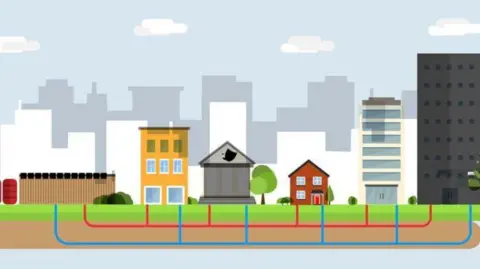Heat network scheme for city awarded £21m
 1Energy
1EnergyA major project to supply Oxford with low carbon heating has been awarded £21m from the government's Green Network Fund.
1Energy plans to install about 20km (12 miles) of pipes, and said it hoped the Oxford Energy Network would be operational by 2030.
Cabinet member for zero carbon at Oxford City Council, Anna Railton, said she was "delighted" by the news, adding: "With buildings responsible for 60% of Oxford's carbon emissions, a heat network like this has been identified as one of the key pathways to achieve a net zero carbon city by 2040."
1Energy said more detail about the project would be revealed in the next six to nine months when a planning application was submitted.
 1Energy
1EnergyProject manager for 1Energy, Dan Goodchild, said: "The vast majority of the heat, 70 or 80% of it, will come from low carbon air source, water source or data centre source heat pumps."
Though he admitted gas might be needed for "resilience purposes, for either when it's particularly cold or when the heat pumps need maintenance".
Nick Eyre, chair of the Zero Carbon Oxfordshire Partnership and emeritus professor of energy and climate policy at the University of Oxford described it as "a good use of government money".
"Heat Networks are going to be required to decarbonise some of the denser populated parts of the country... and that's particularly true in Oxford [which has] a lot of old heritage buildings which are quite difficult to decarbonise," he said.
A similar but much smaller scheme has been running between the John Radcliffe and Churchill hospitals since 2017, after a 1.6-mile (2.2km) pipe was laid under several roads in Headington.
Trevor Payne, director of estates at the University of Oxford said: "The potential benefits of a wider heat network are huge, both for the University - the project could help us achieve our ambitious target of reaching net zero by 2035 - and for the community as a whole."
Jerry Woods, director of estates and campus services at Oxford Brookes University said: "This supports our aims as a member of the Zero Carbon Oxford Partnership in Oxford becoming a Net Zero City by 2040 and also supports the university in reaching its Net Zero carbon goals potentially faster and at lower cost than possible to do alone."
You can follow BBC Oxfordshire on Facebook, X (Twitter), or Instagram.
